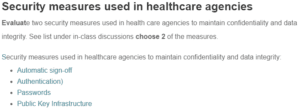Security measures used in healthcare agencies
The privacy of patients, together with their information security, is considered among the major barriers to entry when considering the adoption of electronic health records in healthcare (Kruse et al., 2017). Sewell (2019) claims that firewalls are commonly used to safeguard against unauthorized access. Firewalls operate by examining all messages that enter and leave a system, and those that fail to meet certain criteria are blocked. They also function by denying messages depending on whether the destination port is considered acceptable. It is imperative to ensure constant maintenance of the firewalls and safeguard the system from any prying eyes. White hat hackers can be used to identify any security weakness, thereby enabling actions to safeguard against security breaches found. However, it is important to note that firewalls are unable to enforce password policy or even prevent any misuse of passwords used to ensure data integrity and confidentiality (Thomas & Stoddard, 2017). When there is a lax security policy or poor decisions are made, then firewalls become ineffective.
Audit trails are also commonly used as security measures. An audit trails give a list of individuals that accessed the system as well as activity and time of access (Langer, 2017). Audit trails help safeguard data from prying eyes. Whereas all healthcare professionals should gain access to patient records, this should be followed by an audit trail, which is routinely examined to find out if any breaches have occurred. These trails identify the individual’s username, pages accessed, internet protocol address, and the length of time used to access the information (Sewell, 2019). Audit trails can be highly time-consuming and slow operations, but they are worth the time. Generally, for security measures to be effective, organizations should be committed to training and educating employees on the importance of ensuring data security and ways of protecting patient data.
References
Kruse, C. S., Smith, B., Vanderlinden, H., & Nealand, A. (2017). Security techniques for the electronic health records. Journal of medical systems, 41(8), 1-9.
Langer, S. G. (2017). Cyber-security issues in healthcare information technology. Journal of digital imaging, 30(1), 117-125.
Sewell, J (2019). Informatics and nursing: Opportunities and challenges ( 6th. ed). Wolters Kluwer
Thomas, T. M., & Stoddard, D. (2017). Network Security First-Step: Network Security First. Cisco Press.
ORDER A PLAGIARISM-FREE PAPER HERE
We’ll write everything from scratch
Question
Security measures used in healthcare agencies
Evaluate two security measures used in health care agencies to maintain confidentiality and data integrity. See list under in-class discussions choose 2 of the measures.
Security measures used in healthcare agencies to maintain confidentiality and data integrity:
-
- Automatic sign-off
Security measures used in healthcare agencies
- Authentication)
- Passwords
- Public Key Infrastructure
- Biometrics
- Firewalls
- Application security
- Antivirus software Spyware
- Levels of access
- Audit trails
- Automatic sign-off
APA format.
Sewel, J ( 2019).Informatics and nursing: Opportunities and challenges ( 6th. ed). Wolters Kluwer
ISBN-13: 978-1496394064


